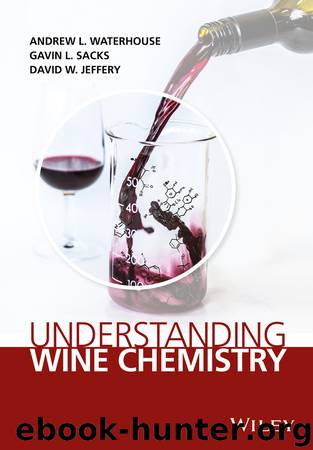Understanding Wine Chemistry by Andrew L. Waterhouse & Gavin L. Sacks & David W. Jeffery

Author:Andrew L. Waterhouse & Gavin L. Sacks & David W. Jeffery
Language: eng
Format: epub
ISBN: 9781118730706
Publisher: Wiley
Published: 2016-09-13T00:00:00+00:00
Notes
1 This “aerobic fermentation” behavior, also referred to as the Crabtree effect, may have evolved in yeast as a way to provide a competitive advantage over other microorganisms due to the antiseptic properties of ethanol. Based on genetic analyses, it is reported that the trait likely evolved at the end of the Cretaceous Age around the same time as fleshy fruits [2].
2 Predicting ethanol yield prior to fermentation in wineries is further complicated because typical sugar measurements on grapes are measured as “soluble solids,” in units of Brix (g of sugar per 100 g of juice). These values are based on physical measurements like density and will usually over-report sugar concentrations by 5–10% due to the presence of other solutes like acids and minerals. Small amounts of ethanol (equivalent to 0.1–0.2% v/v) may also be lost as vapor due to CO2 entrainment. A final complication is that sugar concentrations may be underestimated in shriveled grapes due to higher concentrations of sugar in the skins.
3 In industrial microbiology settings, adding bisulfite to fermentations to induce glycerol formation has been used since 1915, where the glycerol was utilized in production of nitroglycerin explosives.
4 In media with low endogenous acid concentrations, such as in sake production, succinic and other organic acids will represent the major contributors to titratable acidity.
5 Note that this is the third time in this chapter that the reducing environment of fermentation has been mentioned – this is an important concept.
6 As a reminder PV = nRT; solved for V (in litres) given that P = 1 atm, n ≈ 2.22 moles, R = 0.08206 L atm mol-1 K-1 and T = 298.15 K (i.e., 25 °C).
7 The combination of heat and CO2 generation explains the Latin root of fermentation (fervere, “to boil”), a mystical phenomenon until Louis Pasteur’s identification of yeast as the responsible party in the 1860s.
Download
This site does not store any files on its server. We only index and link to content provided by other sites. Please contact the content providers to delete copyright contents if any and email us, we'll remove relevant links or contents immediately.
Alchemy and Alchemists by C. J. S. Thompson(3451)
The Elements by Theodore Gray(3000)
The Club by A.L. Brooks(2863)
How to Make Your Own Soap by Sally Hornsey(2830)
Drugs Unlimited by Mike Power(2545)
Quantitative and Pattern Recognition Analyses of Five Marker Compounds in Raphani Semen using High-Performance Liquid Chromatography by Unknown(2528)
Wheels of Life by Anodea Judith(2098)
Cracking the LSAT, 2012 Edition by Princeton Review(1887)
Cracking the Sat French Subject Test, 2013-2014 Edition by The Princeton Review(1829)
Perfume by Jean-Claude Ellena(1782)
The Flavor Matrix by James Briscione(1777)
The Cosmic Machine: The Science That Runs Our Universe and the Story Behind It by Scott Bembenek(1728)
MCAT Physics and Math Review by Princeton Review(1637)
1000 Multiple-Choice Questions in Organic Chemistry by Organic Chemistry Academy(1621)
The Thing Around Your Neck by Chimamanda Ngozi Adichie(1601)
Handbook of Modern Sensors by Jacob Fraden(1544)
Cracking the SAT Premium Edition with 6 Practice Tests, 2017 by Princeton Review(1539)
Synchrotron Light Sources and Free-Electron Lasers by Eberhard J. Jaeschke Shaukat Khan Jochen R. Schneider & Jerome B. Hastings(1525)
A is for Arsenic: The Poisons of Agatha Christie (Bloomsbury Sigma) by Kathryn Harkup(1507)
